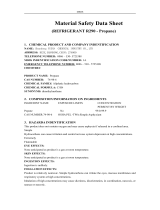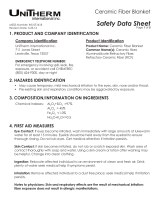
MSDS
If possible, stop the flow of gas with a remote valve. Use water spray to cool exposed containers.
If fire is extinguished and flow of gas is continues, increase ventilation to prevent a build up of a
flammable / explosive atmosphere. Extinguish sources of ignition.
Be cautious of Boiling Liquid Evaporating Vapor Explosion, BLEVE, if flame is impinging on
surrounding containers. Direct a 500 GPM water stream onto containers above the liquid level
with remote monitors. Limit the number of personnel in proximity to the fire. Evacuate
surrounding area to at least 3000 feet in all directions.
6. ACCIDENTAL RELEASE MEASURES
Evacuate all personnel from affected area. Use appropriate protective equipment. Increase
ventilation to prevent build up of flammable/explosive atmosphere. Extinguish all sources of
ignition! If leak is in container or container valve, contact the appropriate emergency telephone
number listed in Section 1 or call Advanced Gas Tech. or CHEMTREC.
7. HANDING AND STORAGE
HANDING AND STORAGE PRECAUTIONS
Earth bond and ground all lines and equipment associated with the product system. Electrical
equipment should be non-sparking and explosion proof. Use only in well-ventilated areas. Valve
protection caps must remain in place unless container is secured with valve outlet piped to use
point. Do not drag, slide, or roll cylinders. Use a pressure regulator when connecting to lower
pressure (250psig) piping or systems. Do not heat cylinder by any means to increase the discharge
rate of product from the cylinder. Use a check valve or trap in the discharge line to prevent
hazardous back flow into the cylinder.
Protect cylinders from physical damage. Store in cool, dry, well-ventilated area away from heavily
trafficked areas and emergency exists. Do not allow the temperature where cylinders are stored to
exceed 130℉ (54℃). Cylinders should be stored upright and firmly secured to prevent falling or
being knocked over. Full and empty cylinders should be segregated. Use a ‘first in – first out’
inventory system to prevent full cylinders from being stored for excessive periods of time.
Post “No Smoking” signs in storage or use areas.
For additional recommendations consult Compressed Gas Association pamphlet P-1.
Never carry a compressed gas cylinder or container of a gas in cryogenic liquid form in as
enclosed space such as a car trunk, van or station wagon. A leak can result in a fire, explosion,
asphyxiation or a toxic exposure.
8. EXPOSURE CONTROLS/PERSONAL PROTECTION
ENGINEERING CONTROLS
Use local exhaust to prevent gas from accumulating. Use general ventilation to prevent build up of
flammable concentrations. Use a hood with ventilation when handing small quantities. If product
is handled routinely where the potential for leaks exists, all electrical equipment must be rated for









